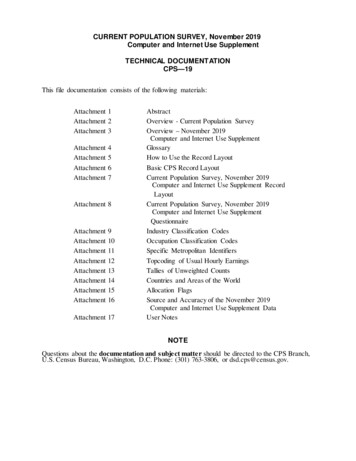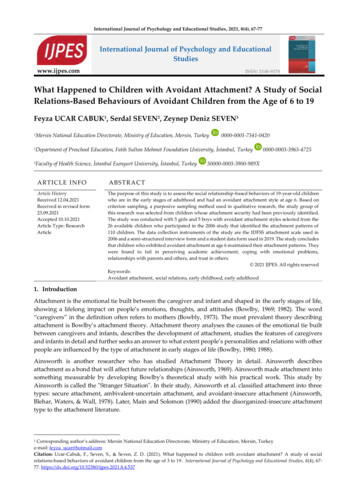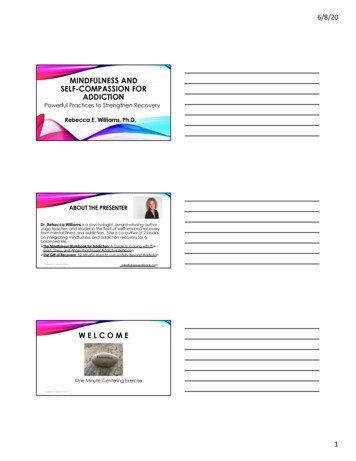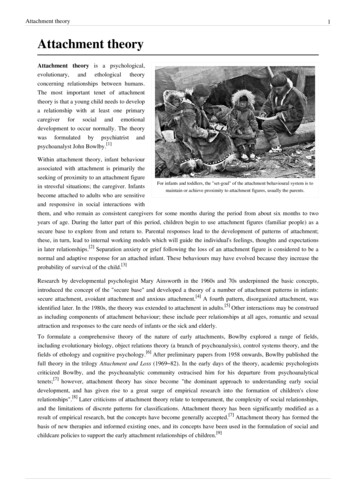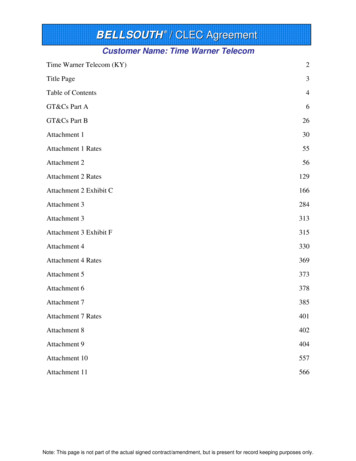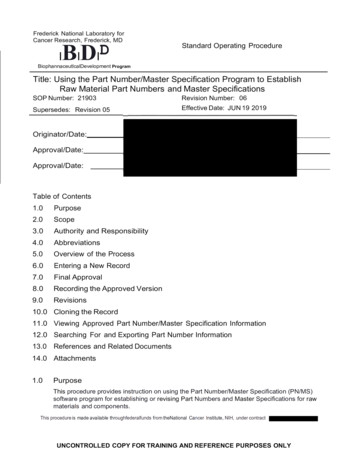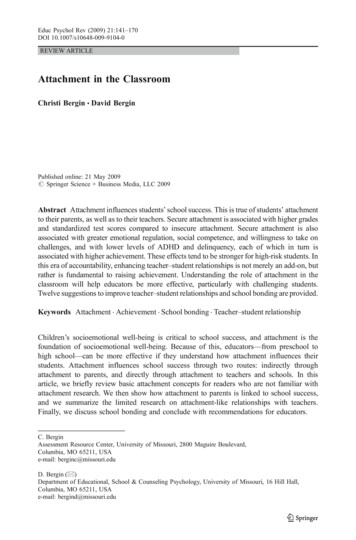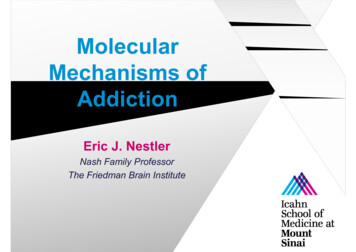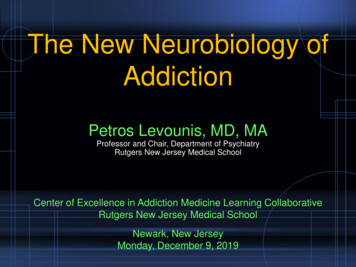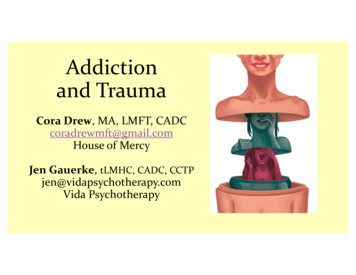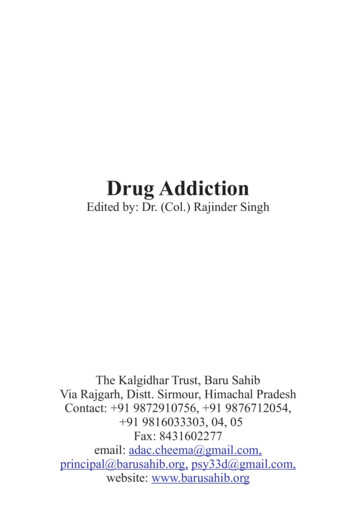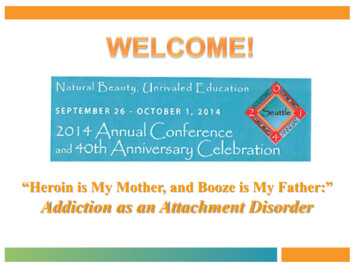
Transcription
“Heroin is My Mother, and Booze is My Father:”Addiction as an Attachment Disorder
“Heroin is My Mother, and Booze is My Father:”Addiction as an Attachment DisorderMichael G BrickerMS, CADC-2, LPCBehavioral Health ClinicianLCS Drug Court Program
Learning Objectives:After today’s Workshop, you should look forward to Being able to identify at least 3 types of childhoodattachment deficits associated with adult SubstanceUse Disorders Understanding how successful SUD treatmentmodalities can effectively remediate dysfunctionalattachment by offering corrective developmentalexperiences Being more comfortable addressing attachmentissues in your own practice, with handoutsyou can use
“Mary, Mary quite contrary how do your neurons grow?”Image: www.brainconnection.com 1999 Scientific Learning Corporation
Brain architecture is built over time (“Epigenetic principle”)
Sequential neuronal developmentAt birth the brain is 25% ofadult size & reaches 90% ofadult size by age 5.The brain develops fromthe bottom up and fromthe back to the front.Impact of theenvironment on thestructure and functionof the brain is greatestduring the first 3 yearsof life.
Hierarchy of Brain DevelopmentFOREBRAINCortex“Executive Center”MIDBRAINLimbic“Emotional Center”HINDBRAINCerebellum &Brainstem“Alarm Center”Abstract ThoughtLogic & ReasoningMemory storageAttachmentContext MemorySexual BehaviorEmotion ReactivityAppetite/SatietyBlood PressureBody TemperatureMotor RegulationBalanceHeart RateBreathing
Neuronal pruning birth age 5 “use it or lose it!”Predominanceof od
Neuronal plasticity has its limits
“Mirror Neurons” seem to beimportant in this process Discovered in the mid-1990’s in monkeys Theoretically, they provide an internal“mirror” of other’s actions, intentions andemotions This becomes an internal representation ormap of interactions with important “others” Could they be the foundation of attachment?
Gene EnvironmentinteractionsEnvironmental interactionscan influence genes as theyare “expressed”. Theirintensity can either reduceor increase genetically basedrisks.
Interaction of nature and nurtureBiologyshapesability to:RecognizespeechDiscernsoundsLink meaningto wordsThe nedVocabularyDialect
Mirror Neurons areimportant in parenting:When you focus on your children's innerexperiences (feelings), something reallyimportant is happening. This focus helpsyou develop a balanced way of regulatingyour child’s emotional states. For example,when you interact using mirror neurons youcan both calm your child when he or she isupset, and you can teach your child to calmhim or herself.Jacque RistauMS, LPC, 2006
Implications First 2 years of life is“blooming” of the prefrontal cortex Experience-basedinteraction is essentialto the process Implicit vs explicitmemory Early experiences reinforced by interactions All children will attach ;what differs is thequality of attachment– To what or whom?– Secure or insecure– Malleable or not? Patterns are persistentbut can change Anger and aggressionare most stable
The child’s brain developmentis governed by 2 processes:Blooming: As the child’sbrain grows there is aninitial “sprouting” ofneurons and synapticjunctions.Pruning: Those neuronsthat are not encouragedto fire gradually atrophyin favor of neuronalconnections that areused.Due to the infant’s limited psychomotor capacity, the brainat this point is a passive recipient, waiting for anexperience. As experiences, interactions andenvironmental stimulation are provided these activatedneurons shape the actual structure of the brain.
And the result is:
Attachment is not just for babies anymore it becomes part of or survival system.(Have you ever had a “gut hunch”about somebody?)Lewis, et. al. (2000)
By the time a child is a year old, they havemade the three most important decisionsthey will ever make: The world is a safe place for me, orit’s not If I make my needs known, they will bemet, they’ll be frustrated or (worst ofall ) I can never tell Either the world is glad that I’m here,or it’s not
Michael G Bricker MS, CADC-2, LPC (2002)
The child’s answer to these three questionsbecomes a “life posture” that is preconscious and durable across the life spanChronic traumaresponseHypervigilenceTrust issuesAttachment D/O’sPersonality D/O’sSecurityMyNO worldis safeYESHealthyAttachmentStablerelationships
The child’s answer to these three questionsbecomes a “life posture” that is preconscious and durable across the life spanInsecurityAmbivalenceTrust issuesExtremes MyNO needs YESare metSense of worthHealthyAttachmentStablerelationships
The child’s answer to these three questionsbecomes a “life posture” that is preconscious and durable across the life spanInsecurityDepressionTrust alitySecurityWorldNO is glad YESI’mherePositiveself- worthHealthyAttachmentStablerelationships
The child’s answer to these three questionsbecomes a “life posture” that is preconscious and durable across the life spanWhen asked to evaluate kids because a parent or professional suspectsRAD, the child is usually exhibiting some combination of problematicbehaviors from the following list: Lack of conscience or empathy for others, manifesting in antisocialWorldbehaviorglad Severe aggression that (atistimes)may appear deliberate on the partof the childI’m Property destructionhere Pathological lying Stealing Removing and hiding food from the family’s kitchen or refrigerator Inappropriate sexual behavior Manipulative behavior
Origins of Attachment TheoryAnn W Smith MS, LPC, LMFT, NCC
Ann W Smith MS, LPC, LMFT, NCC
Mirrorneurons arethe basis ofattunement whichleads toattachmentAfter Bessel Van Der Kolk MD
Ann W Smith MS, LPC, LMFT, NCC
Ann W Smith MS, LPC, LMFT, NCC
Ann W Smith MS, LPC, LMFT, NCC
Ann W Smith MS, LPC, LMFT, NCC
Ann W Smith MS, LPC, LMFT, NCC
Attachment is influencedby trauma or neglect:CAPACITY FOR RELATIONSHIPSIntimacy ---------------------------- IsolationIDENTITYSecure sense of self -- Identity confusionSELF-EFFICACYSense of mastery -------- PowerlessnessSELF-REGULATIONSelf-control --------------------- ImpulsivityAfter Teresa Stroup, MSW
Dr Daniel Sonkin
Dr Daniel Siegel
Dr Daniel Siegel
Experiencecreatesexpectationwhich altersperceptionwhich shapesbehavior
Where does it go wrong? As biological beings, we are “hard-wired” atbirth for survival, attachment, pleasure andcomfort (homeostasis) Brainstem & limbic functions: increases in––––dopamine (motivation & pleasure)oxytocin (bonding & comfort)PEA (excitation & arousal)Vasopressin (social & sexual motivation) Trauma or neglect create highly reinforcedneural pathways in unconscious and preconscious “survival brain” systems
Where does it go wrong?Inconsistent attachment results in diffusememory formation (“fun-house mirror”neurons)Trauma “splintered” memory formationstress fragmented memory storage w/omarkers for conscious recall flashbacksNeglect mis-attribution of self Victimstance: “What’s WRONG with me?” vs“What’s happening to me?”
Where does addiction come in? We are “hard-wired” at birth for survival,attachment, pleasure and comfort. This is abiological imperative, and WILL be satisfied Brainstem & limbic functions––––dopamine (motivation & pleasure)oxytocin (bonding & comfort)phenylethylamine PEA (excitation & arousal)vasopressin (social & sexual motivation) For genetically vulnerable persons, drugintoxication fires the same parts of the brain,and feels like an acceptable substitute
Where does addiction come in? For genetically vulnerable persons, drugintoxication fires the same parts of the brain,and feels like an acceptable substitute “Loaded feels like love!”
The Benefits of OxytocinFear - CortisolCOMFORT - OxytocinAggressionAnti-stress hormoneCauses arousal, Anxiety, Feelingstressed-outActivates addictionsFeeling calm and connected,Increased curiositySuppresses libidoIncreases sexual receptivity –promotes orgasm in womenAssociated with depressionPositive feelingsCan be toxic to brain cellsFacilitates learningBreaks down muscles, bones andjointsWeakens immune systemRepairs, heals and restoresIncreases painDiminishes sense of painClogs arteries, Promotes heartdisease and high blood pressureLowers blood pressure, Protectsagainst heart diseaseObesity, Diabetes, OsteoporosisLessens cravings & addictionsFaster wound healingWhich way would you vote?
Dopamine otivatedAnxietyDepressionCompulsionsAnhedonia - no pleasure,world looks colorlessFeelings of well-being,satisfactionPleasure, reward inaccomplishing tasksSexual fetishesLack of ambition and driveHealthy libidoSexual addictionInability to "love”Low libidoGood feelings towardothersHealthy bondingGamblingErectile dysfunctionHealthy risk takingCompulsive activitiesNo remorse about personalbehaviorSound choicesAggressionADD/ADHDRealistic expectationsPsychosisSocial anxiety disorderMaternal/Paternal loveUnhealthy risk-takingSchizophreniaAntisocial behavior
Actions of PEA on Neurotransmitters Stimulates dopamine’s nerve terminals and activity forfeeling pleasure, libido and emotional wellbeing; Increases epinephrine and norepinephrinecatecholamine activity, for energy production andinhibition of their reuptake; Increases the action of acetylcholine for cognitivefunctions by stimulating the AMPA glutamatereceptors; Elevates mental alertness and mood by suppressingthe inhibitory effects of GABA-B receptors; Enhances serotonin release and its uplifting activity onmood, emotions and control.
Where does addiction come in? Brainstem & limbic functions are similar inpositive attachment and intoxication– dopamine – responds to pleasurable events thatare novel and significantly better than expected– oxytocin – may function to “bond” the user to thenew and pleasurable experience– PEA – triggers the “giddy” lovestruck feeling– vasopressin – may close the motivation loop For attachment-deprived persons, drugintoxication fires the same parts of the brain,and feels like an acceptable substitute So, in the absence of dependable attachment:LOADED WILL DO!
The goal of attachment is homeostasisin a “felt sense of security”3 main characteristics Safe haven – who youturn to when upset Proximity – who do youwant to be close to Secure base – who isalways there for you (Remember Maslow’sPyramid?)3 main functions Reduces stresshormones like cortisol Increase bondingneuropeptides like PEA,oxytocin & vasopressin Shift from sympathetic(activating) to parasympathetic (calming)Autonomic NS
DSM-5 Attachment Disorder revisions
DSM-5 Attachment Disorder revisions Moved out of “disorders Reactive Attachmentof Infancy and earlyDisorderchildhood” in DSM-IV– Minimal emotionalengagement DSM-IV Criteria A & B– Limited positive affectsplit and treated as– Unexpected fear/angerseparate disorders Disinhibited Social Redefined as a traumaEngagement D/Odisorder– Overly familiar verbal &physical behavior withstrangers
Implications for Recovery When we get sober, wenow have lost our“attachment surrogate” The biological imperative is still in force Lacking the developmental attachmentskills, secure sense ofself and self-soothingskills we look for somethingelse to fill the void, eg. cross-addiction “process” addictions and last, but not least the “13th Step” ! Wefind someone who feelslike they’re “the ONE ” so we still don’tdevelop the skills!
Implications for Recovery Now we’re faced withthree unpleasantalternatives:– Sequential engulfment(ultimately unsatisfying)– Isolation (violates thebiological imperative)– Grow up! Get to knowwho I am so that I canconnect in a healthy,meaningful way. So how do we do THAT?We need to find developmentally appropriateexperiences– Unconditional acceptance– Peer support groups Reciprocal positiverelationships– Counseling & therapy– Sponsorship & mentoring
Implications for RecoverySuccessiveunsuccessfulattempts to fillthe void left byinsecureattachment inearly childhood.Lack of secureattachment[after Terry Kellogg]
Working hypothesis: attachmentissues operative at 2 points in time? Early initiation ofsubstance misuse?– CNS depressants– Ages 7-10 suggest earlysexual abuse?– Ages 10-12 suggestinsecure attachment Antisocial PDO’s– Early MJ and ETOH CNS stimulants age 14 Early initiation ofabstinence?– Boundary issues w. Staff– “13th Step” violations– Withdrawal fromsupport as Tx proceeds Beware the “antisocialborderline dyad”– People who “need to beneeded” and peoplewho need to dominate
Implications for Treatment Task is to make the unconscious conscious Well-designed treatment provides sequential“developmentally corrective experiences”– Empathy, genuine-ness and unconditional positiveregard (sound familiar?)– This allows the INNER experience of attachmentto develop, including– Healthy boundaries between “self” and “other” Opportunities to risk new behaviors in asafe, supportive learning environment
Implications for Treatment Engagement is even MORE important with theattachment-challenged adult “They don’t care what you know ‘till theyknow that you CARE.” Manualized EBP’s alone may be less effectivewithout adjunctive “process work”– Personality D/O’s are usually screened out ofstudy cohorts – Attachment becomes a confounding variable
Implications for Treatment A developmental assessment is essential– The client who was securely attached as a childwill benefit from education & skill-building– These may not be sufficient for those with earlyattachment deficits– Particularly clients with borderline and dependentpersonality characteristics will require conjointtherapy to consolidate recovery gains Antisocial personalities are another story
Implications for Treatment Clients with attachmentissues may tend to selfsabotage with oldpatterns Knowing what the “oldpatterns” look like mayhelp keep them fromrepeating Get an “attachmenthistory” Adverse ChildhoodExperiences Survey Adult AttachmentInterview Review of past relapseexperiences throughthe “attachment lens” What did relapse “feellike?” Familiar?
The 12 Steps offer developmentallysequenced corrective experiences:1. The experience of abandonment & betrayal2. Permission to Hope – attunement to others3. Risking Attachment4. Risking attunement with self5. Risking attachment with another6-7 Repairing my relationship with myself8-9 Repairing my relationship with others10. Owning responsibility for my relationships11. Cementing attachment to my Higher Power12. Expanding that relationship to others
The Women for Sobriety“New Life Acceptance” Program1.I have a life-threatening problem that once had me I now take chargeof my life and my disease. I accept responsibility for my life.2. Negative thoughts hurt only myselfMy first conscioussober thought must be to remove negativity from my life3. Happiness is a habit I will developHappiness is created, not waited for4. Problems bother me only to the degree I permit them toI now better understand my problems, and don’t let them overwhelm me5. I am what I thinkI am a capable, competent, caring compassionate woman (person)6. Life can be ordinary, or it can be greatGreatness is mine by conscious effort
7.Love can change the course of my worldCaring becomes all-important8.9.The fundamental object of life is emotional and spiritualgrowth Daily I put my life into proper order, knowing which are my prioritiesThe past is gone foreverNo longer will I be victimized by the past. I am a new person10.All love given returnsI will learn to know that others love me11.Enthusiasm is my daily exerciseI treasure all moments of my new life12.I am a competent woman and have much to give lifeThis is what I am and I will know it always13.I am responsible for myself and my actionsI am in charge of my mind, my thoughts and my life
Implications for Treatment –get an attachment history[in your handouts permission to reproduce]
Implications for Treatment –get an attachment historyNICHD SECCYD—WisconsinADULT ATTACHMENT SCALEPlease read each of the following statements and rate the extent to which itdescribes yourfeelings about close relationships in general. That is, we want you to thinkabout how you feel in all close relationships including your romanticrelationships, friendships, and familyrelationships. Please use the scale below and indicate the degree to whicheach statement ischaracteristic of you by placing a number between 1 and 5 in the spaceprovided to the right of each ----5Not at all characteristicVery characteristic[in your handout public domain]
Implications for Treatment –get an attachment history[in your handouts public domain]
The Cycle of the Breath in Restoring Self“Emotions” - MINDSense ofSELF“Feelings” - BODY
Questions?Comments?
Further ResourcesPhilip J. Flores, Ph.D. (2004).From the Foreword:"Addiction is a disorder in self-regulation.Individuals who become dependent onaddictive substances cannot regulate theiremotions, self-care, self-esteem, andrelationships. In this monumental andilluminating text Flores covers all thereasons why this is so. But it is the domainof interpersonal relations that he makes clearwhy individuals susceptible to substance usedisorders (SUDs) are especially vulnerable.His emphasis on addiction as an attachmentdisorder is principally important because heprovides extensive scholarly and clinicalinsights as to why certain vulnerableindividuals so desperately need to substitutechemical solutions and connectionsfor human ones.
Further ResourcesBook DescriptionPublication Date: November 17,2006 ISBN-10: 0393704548 ISBN-13: 978-0393704549 Edition: A visual exploration ofhow the brain developsthroughout our lives.Just as neurons communicatethrough mutual stimulation, brainsstrive to connect with one another.Louis Cozolino shows us howbrains are highly social organisms.Balancing cogent explanation withinstructive brain diagrams, hepresents an atlas of sorts,illustrating how the architectureand development of brain systemsfrom before birth through adulthooddetermine how we interact withothers.Editorial ReviewsCozolino adds. impressivecontributions to the increasinglyimportant field of neurobiologyand attachment theory, and howthese contribute to humandevelopment. (Clinical SocialWork, Dennis Miehls) REVIEW:Reading this book has added awhole new dimension to my workand everyday life. Highlyrecommended. (Therapy Today,Andrew Barley)Reading this book has added awhole new dimension to my workand everyday life. Highlyrecommended
Further ResourcesDr. Bruce Perry – Attachment and the brainDr. Perry provides the below free online courses at his website. Heis currently transitioning to a new website. The newer address ishttp://childtraumaacademy.org/default.aspx"Our online university offers free online courses for interestedparticipants. Currently we have four self-directed online courses. "The Amazing Human Brain and Human DevelopmentSurviving Childhood: An Introduction to the Impact of TraumaThe Cost of Caring: Secondary Traumatic Stress and the Impact ofWorking with High-Risk Children and FamiliesBonding and Attachment in Maltreated Children
Further ResourcesDr Bruce Perry MD, PhDEmail: ChildTrauma@ChildTraumaAcademy.orgPhone: (866) 943-9779Fax: (713) 513-5465Web Site: www.ChildTrauma.orgOnline Store: www.CTAProducts.orgOnline University:www.ChildTraumaAcademy.com
Further ResourcesWhat is your attachment style?This interactive survey takes about 5 minutes to complete. Thequestionnaire is designed to measure your 'attachment style'--theway you relate to others in the context of intimate relationships.When completed, the site will reveal your attachment style, andprovide a brief summary of what is known about your attachmentstyle on the basis of contemporary scientific rq.plYou must be 18 years or older to participate. By clicking the abovebutton, you certify that you are 18 years or older.This application was developed by R. Chris Fraley and is to be usedfor educational purposes only. The application is based on theExperiences in Close Relationships-Revised measure of adultattachment styles
Further Resources Dr Gabor Mate: t Theory and the Brain: Dr. Daniel Sonkin– Wounded Men and Domestic ViolenceAttachment Theory and the Developmental Consequences ofRelational Trauma by Dr. Jon Caldwell D.O. The MeadowsDemystifying Addiction: Understanding Addiction asAttachment Disorder By Thomas Hedlund the Meadows,August 17, 2012Addiction as an Attachment Disorder: Implications forGroup Therapy Philip J. Flores1, p.51.1.63.49730?journalCode ijgp Dr. Dan Siegel - On Optimal Attachment – YouTubewww.youtube.com/watch?v XjXv6zseA0
Quyana!(Thank You!)
Michael G. Bricker MS, CADC-II, LPCThe STEMSS InstituteSupport Together for Emotional & Mental Serenity and SobrietyConsultation inrecovery fromsubstance use andmental disordersPO Box 10285341 Bryant AvenueKlamath Falls OR 97601Phone: (541) 880 - 8886Email: mbricker6421@gmail.comPromoting dual recovery since 1984
-Secure or insecure -Malleable or not? Patterns are persistent but can change Anger and aggression are most stable . Blooming: As the child [s . Loaded feels like love! The Benefits of Oxytocin Fear - Cortisol COMFORT - Oxytocin Aggression Anti-stress hormone Causes arousal, Anxiety, Feeling stressed-out
